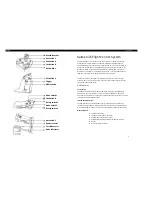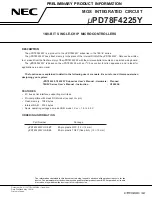
CM-2201/CM-2202
Troubleshooting
©2018 Nelson Heat Tracing Systems
www.nelsonheaters.com
GA2497 Rev.6
17
Note: Some manufacturers use the common Black-White-
Red triad color code for the RTD connections. Usually, the
RED lead is the common connection (same as the White-White-
Red color scheme) and the White and Black connections may be
used interchangeably.
2.
Temperature Verification
If you consider that the indicated or displayed temperature is
not correct, the controller and the RTD can be quickly
checked for correct operation. To verify the RTD:
TURN THE POWER TO THE CONTROLLER OFF BEFORE
PROCEEDING!
a)
Disconnect the RTD wiring from the input terminals.
b)
To calculate the temperature indicated by the RTD,
measure the resistance from source (red wire) or
sense (red wire) to common (white wire) and subtract
the resistance measured between source and sense. This
will give a compensated resistance value that can be
cross- referenced to one of the RTD tables found in
Appendix
E or Appendix F. Compare the measured resistance and
cross-referenced temperature value obtained from the
RTD table to the indicated or displayed value. These
should agree to within the accuracy standards of the
CM2201/CM2202 and the RTD.
Note: Ensure you refer to the correct RTD table for the type of
RTD you are using
To verify the Controller:
TURN THE POWER TO THE CONTROLLER OFF BEFORE
PROCEEDING!
a)
Disconnect the RTD wiring from the input terminals.
b)
Connect a 100 Ω resistor across the source or
sense terminal and common. Insert a jumper
between the source and sense terminals.
c)
Apply power to the controller. The indicated or
displayed temperature should be about 32°F (0°C)
depending on the actual resistance of the test resistor if
RTD TYPE is set to 100 Ω Platinum. Any resistor may
have a +/- 10% tolerance.
3.
Unstable Temperature
An erratic indication of temperature can be caused by several
factors external to the controller. The controller’s accuracy and
resolution will result in an indicated temperature change of a
couple of degrees if the measured resistance temperature
falls between two discrete values (this is sometimes
referred to as quantization error).
If the instability is excessive, check:
a)
Wire used for extension of the RTD should be three-
wire, twisted and shielded with the shield grounded at the
controller only. Each of the three lead wires must be of the
same gauge.
b)
The ideal installation has a separate conduit for the RTD
leads (if they have been extended). It is not usually a
problem to run low signal levels in the same conduit as
the power leads even in high power applications, as long
as the RTD wire is a twisted, shielded type with an
insulation rating equal to or greater than the highest
voltage in the conduit. Follow the proper Electrical Code
requirements for your particular installation.
c)
Check the specifications for the particular cable
being used to ensure that it does not have excessive
Capacitance when used in long lengths. This can
cause a temperature offset between what the controller
reads and what the RTD actually measures. This again is
normally not a problem since the controller compensates
for all but the worst cases of this.
d)
Check one by one if the all RTD leads are connected to
the connector.
e)
Lastly, it is possible for the RTD itself to fail
on an intermittent basis, but this failure mode
should be considered unusual. This kind of failure is
probably the most difficult to find but fortunately it is
also the least likely as a failure mechanism.
















































